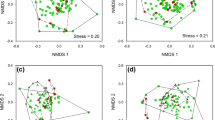Summary
Two species of salamander larvae (Ambystoma talpoideum and A. maculatum) were reared separately in the presence and absence of a fish (Lepomis macrochirus) in artificial ponds to measure the effects of a predator on the growth, survival, diet, and activity of larvae. The presence of L. macrochirus reduced body sizes of larvae by 18% in A. talpoideum and by 16% in A. maculatum. L. macrochirus apparently preyed on the smallest individuals. Survival in the presence of L. macrochirus decreased by 61% in A. talpoideum and by 97% in A. maculatum compared with larvae reared alone. Species identity did not significantly effect body size or survival, but an interaction effect suggested that A. maculatum was more severely affected by predators than was A. talpodeum. Activity of larvae in the water column was dramatically reduced in the presence of L. macrochirus, when larvae were restricted to the leaf litter of the benthic zone. There was overlap in the diets of fish and salamander larvae. Larvae reared in the presence of fish, however, consumed different taxa of prey as well as reduced number of prey compared to larvae reared alone. A. talpoideum larvae were more nocturnal than diurnal in the absence of fish, whereas A. maculatum larvae were equally active day and night. This experiment suggests that predator-prey relationships can change with shifts in species attributes and potentially confound apparent costs of predator avoidance with competition. Measuring the long-term dynamics of the cost-benefit relationship will help elucidate how prey balance the demands of their life history with the demands of predators.
Similar content being viewed by others
References
Caldwell JP, Thorp JH, Jervey TO (1980) Predator-prey relationships among larval dragonflies, salamanders, and frogs. Oecologia (Berlin) 46:285–289
Cecil SG, Just JJ (1979) Survival rate, population density and development of a naturally occurring anuran larvae (Rana catesbeiana). Copeia 1979:447–453
Cerri RD, Fraser DF (1983) Predation and risk in foraging minnows: balancing conflicting demands. Am Nat 121:552–561
Charnov EL, Orians GH, Hyatt K (1976) Ecological implications of resource depression. Am Nat 110:247–259
Crump ML (1981) Variation in propagule size as a function of environmental uncertainty for tree frogs. Am Nat 117:724–737
Edwards J (1983) Diet shifts in moose due to predator avoidance. Oecologia (Berlin) 60:185–189
Efford IE, Mathias JA (1969) A comparison of two salamander populations in Marion Lake, British Columbia. Copeia 1969:723–736
Formanowicz DR, Jr, Brodie DE, Jr (1982) Relative palatabilities of members of a larval amphibian community. Copeia 1982:91–97
Gliwicz MZ (1986) Predation and the evolution of vertical migration in zooplankton. Nature 320:746–748
Grubb JC (1972) Differential predation by Gambusia affinis on the eggs of seven species of anuran amphibians. Am Midl Nat 88:102–108
Hall DJ, Werner EE (1977) Seasonal distribution and abundance of fishes in the littoral zone of a Michigan lake. Trans Am Fish Soc 106:545–555
Heyer WR, McDiarmid RW, Weigmann DL (1975) Tadpoles, predation, and pond habitats in the tropics. Biotropica 7:100–111
Holomuzski JR (1986) Predator avoidance and diel patterns of microhabitat use by larval tiger salamanders. Ecology 67:737–748
Howard RD (1983) Sexual selection and variation in reproductive success in a long-lived organism. Am Nat 122:301–325
Kaplan RH, Salthe SN (1979) The allometry of reproduction: an empirical view in salamanders. Am Nat 113:671–689
Milinski M, Heller R (1978) Influence of a predator on the optimal foraging behaviour of sticklebacks (Gasterosteus aculeatus L.). Nature 275:642–644
Morin PJ (1986) Interactions between intraspecific competition and predation in an amphibian predator-prey system. Ecology 67:713–720
Ohman MD, Frost BW, Cohen EB (1983) Reverse diel vertical migration: an escape from invertebrate predators. Science 220:1404–1407
Petranka JW (1983) Fish predation: a factor affecting spatial distribution of a stream-breeding salamander. Copeia 1983:624–628
Salthe SN (1969) Reproductive modes and the number and sizes of ova in the urodeles. Am Midl Nat 81:467–490
Schultz JC (1981) Adaptive changes in antipredator behavior of a grasshopper during development. Evolution 35:175–179
Semlitsch RD (1985) Reproductive strategy of a facultatively paedomorphic salamander Ambystoma talpoideum. Oecologia (Berlin) 65:305–313
Semlitsch RD (1987) Paedomorphosis in Ambystoma talpoideum: effects of density, food, and pond drying Ecology 68 (in press)
Sih A (1980) Optimal behavior: can foragers balance two conflicting demands? Science 210:1041–1043
Sih A (1982) Foraging strategies and the avoidance of predation by an aquatic insect, Notonecta hoffmanni. Ecology 63:786–796
Sih A (1986) Antipredator responses and the perception of danger by mosquito larvae. Ecology 67:434–441
Snedecor GW, Cochran WG (1980) Statistical methods, 7th ed. Iowa State University Press, Ames, Iowa, USA
Stangel PW, Semlitsch RD (1987) Experimental analysis of predation on the diel vertical migrations of a larval salamander. Can J Zool 65 (in press)
Stein RA (1977) Selective predation, optimal foraging, and the predator-prey interactions between fish and crayfish. Ecology 58:1237–1253
Stein RA, Magnuson JJ (1976) Behavioral response of crayfish to a fish predator. Ecology 57:751–761
Vance RR, Schmitt RJ (1979) The effect of the predator-avoidance behavior of the sea urchin, Centrostephanus coronatus, on the breadth of its diet. Oecologia (Berlin) 44:21–25
Verrell PA (1982) Male newts prefer large females as mates. Anim Behav 30:1254–1255
Werner EE, Hall DJ (1974) Optimal foraging and size selection of prey by the bluegill sunfish (Lepomis macrochirus). Ecology 55:1042–1052
Werner EE, Hall DJ (1979) Foraging efficiency and habitat switching in competing sunfishes. Ecology 60:256–264
Werner EE, Mittelbach GG, Hall DJ, Gilliam JF (1983a) Experimental tests of optimal habitat use in fish: the role of relative habitat profitability. Ecology 64:1525–1539
Werner EE, Gilliam JF, Hall DJ, Mittelbach GG (1983b) An experimental test of the effects of predation risk on habitat use in fish. Ecology 64:1540–1548
Werschkul DF, Christensen MT (1977) Differential predation by Lepomis macrochirus on the eggs and tadpoles of Rana. Herpetologica 33:237–241
Wilbur HM (1980) Complex life cycles. Ann Rev Ecol Syst 11:67–93
Zaret TM, Suffern JS (1976) Vertical migration in zooplankton as a predator avoidance mechanism. Limn Oceanogr 21:804–813
Author information
Authors and Affiliations
Rights and permissions
About this article
Cite this article
Semlitsch, R.D. Interactions between fish and salamander larvae. Oecologia 72, 481–486 (1987). https://doi.org/10.1007/BF00378972
Received:
Issue Date:
DOI: https://doi.org/10.1007/BF00378972




